
Vankka J. - Digital Synthesizers and Transmitters for Software Radio (2000)(en)
.pdf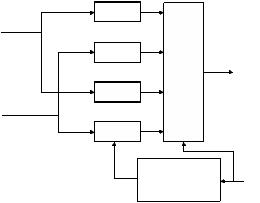
Direct Digital Synthesizers |
69 |
|
|
|
|
|
|
|
|
|
|
|
Digital |
|
|
|
h |
|
|
|
|
|
|
||
I |
|
|
4 |
k |
|
|
|
|
IF Output |
||
|
|
|
|
|
|
|
|
|
|
||
|
|
|
|
|
|
|
|
|
|
|
Centered |
|
|
h |
|
|
|
|
|
|
|
||
|
|
4 |
k+ |
1 |
|
|
|
at 1/Tsym |
|||
|
|
|
|
|
|
|
|
|
4:1 |
|
|
|
|
|
|
|
|
|
|
||||
|
|
|
|
|
|
|
|
|
|||
MUX
-h4k+2
Q
-h4k+3
1/Tsym |
Clock |
|
4 |
|
4/Tsym |
Clock |
|
|
|
|
|||
|
|
|
|
Input |
||
|
|
|
|
|
||
|
|
|
|
|
|
|
Figure 4-6 Simplified digital modulator.
enables the transmission of signals having different symbol rates.
REFERENCES
[Ahm89] H. M. Ahmed, "Efficient Elementary Function Generation with Multipliers," in Proc. 9th Symposium on Computer Arithmetic, Santa Monica, CA, USA, Sept. 1989, pp. 52-59.
[Bra81] A. L. Bramble, "Direct Digital Frequency Synthesis," in Proc. 35th Annu. Frequency Contr. Symp., USERACOM (Ft. Monmouth, NJ), May 1981, pp. 406-414.
[Cro83] R. E. Crochiere, and L. R. Rabiner, "Multirate Digital Signal Processing," Englewood Cliffs, NJ: Prentice-Hall, 1983.
[Cur01] F. Curticãpean, and J. Niittylahti, "An Improved Digital Quadrature Frequency Down-Converter Architecture," Asilomar Conf. on Signals, Syst. and Comput., Nov. 2001, pp. II-1318-1321.
[Dar70] S. Darlington, "On Digital Single-Sideband Modulators," IEEE Trans. Circuit Theory, Vol. 17, No. 3, pp. 409-414, Aug. 1970.
[Dut78] D. L. Duttweiler, and D. G. Messerschmitt, "Analysis of Digitally Generated Sinusoids with Application to A/D and D/A Converter Testing," IEEE Trans. on Commun., Vol. COM-26, pp. 669-675, May 1978.
[Gol96] B. G. Goldberg, "Digital Techniques in Frequency Synthesis," McGraw-Hill, 1996.
[Gor75] J. Gorski-Popiel, "Frequency-Synthesis: Techniques and Applications," IEEE Press, New York, USA, 1975.
[Hog81] E. B. Hogenauer, "An Economical Class of Digital Filters for Decimation and Interpolation," IEEE Trans. Acoust., Speech, Signal Process., Vol. ASSP-29, No. 2, pp. 155-162, Apr. 1981.
70 Chapter 4
[McC88] E. W. McCune, Jr., "Number Controlled Modulated Oscillator," U. S. Patent 4,746,880, May 24, 1988.
[Mey98] U. Meyer-Bäse, S. Wolf, and F. Taylor, "Accumulator-Synthesizer with Error-Compensation," IEEE Trans. Circuits and Systems II, Vol. 45, No. 7, pp. 885 - 890, July 1998.
[Nak97] T. Nakagawa, and H. Nosaka, "A Direct Digital Synthesizer with Interpolation Circuits," IEEE J. of Solid State Circuits, Vol. 32, No. 5, pp. 766-770, May 1997.
[Nic87] H. T. Nicholas, and H. Samueli, "An Analysis of the Output Spectrum of Direct Digital Frequency Synthesizers in the Presence of PhaseAccumulator Truncation," in Proc. 41st Annu. Frequency Contr. Symp., June 1987, pp. 495-502.
[Nie98] J. Nieznanski, "An Alternative Approach to the ROM-less Direct Digital Synthesis," IEEE J. of Solid State Circuits, Vol. 33, No. 1, pp. 169 -
170, Jan. 1998.
[Nos01a] H. Nosaka, Y. Yamaguchi, and M. Muraguchi, "A Non-Binary Direct Digital Synthesizer with an Extended Phase Accumulator," IEEE Transactions on Ultrasonics, Ferroelectrics and Frequency Control, Vol. 48, pp. 293-298, Jan. 2001.
[Nos01b] H. Nosaka, Y. Yamaguchi, A. Yamagishi, H. Fukuyama, and M. Muraguchi, "A Low-Power Direct Digital Synthesizer Using a SelfAdjusting Phase-Interpolation Technique," IEEE J. Solid-State Circuits, Vol. 36, No. 8, pp. 1281-1285, Aug. 2001.
[Nuy90] P. Nuytkens, and P. V. Broekhoven, "Digital Frequency Synthesizer," U. S. Pat. 4,933,890, June 12, 1990.
[Rah01] T. Rahkonen, H. Eksymä, A. Mäntyniemi, and H. Repo, "A DDS Synthesizer with Digital Time Domain Interpolator," Analog Integrated Circuits and Signal Processing, Vol. 27, No. 1-2, pp. 111-118, Apr. 2001.
[Ric01] R. Richter, and H. J Jentschel, "A Virtual Clock Enhancement Method for DDS Using an Analog Delay Line," IEEE J. Solid-State Circuits, Vol. 36, No. 7, pp. 1158-1161, July 2001.
[Son03] Y. Song and B. Kim, "A 330-MHz 15-b Quadrature Digital Synthesizer/Mixer in 0.25 µm CMOS," in Proc. 29th European Solid-State Circuits Conference, Estoril, Portugal, Sept. 2003, pp. 513-516.
[Sta94] Stanford Telecom STEL-2173 Data Sheet, the DDS Handbook, Fourth Edition, and Triquint Semiconductor TQ6122 Data Sheet, TQS Digital Communications and Signal Processing, 1994.
[Tan95a] L. K. Tan, and H. Samueli, "A 200 MHz Quadrature Digital Synthesizer/Mixer in 0.8 m CMOS," IEEE J. of Solid State Circuits, Vol. 30, No. 3, pp. 193-200, Mar. 1995.
Direct Digital Synthesizers |
71 |
[Tie71] J. Tierney, C. Rader, and B. Gold, "A Digital Frequency Synthesizer," IEEE Trans. Audio and Electroacoust., Vol. AU-19, pp. 48-57, Mar.
1971.
[Tor03] A. Torosyan, D. Fu, and A. N. Willson, Jr., "A 300-MHz Quadrature Direct Digital Synthesizer/Mixer in 0.25 m CMOS," IEEE J. of Solid State Circuits, Vol. 38, No. 6, pp. 875-887, June 2003.
[Web72] J. A. Webb, "Digital Signal Generator Synthesizer," U. S. Patent 3,654,450, Apr. 4, 1972.
[Wen95] A. Wenzler, and E. Lüder, "New Structures for Complex Multipliers and their Noise Analysis," in Proc. IEEE International Symposium on Circuits and Systems (ISCAS), 1995, pp. 1,432-1,435.
[Won91] B. C. Wong, and H. Samueli, "A 200-MHz All-Digital QAM Modulator and Demodulator in 1.2- m CMOS for Digital Radio Applications," IEEE J. Solid-State Circuits, Vol. 26, No. 12, pp. 1970-1979, Dec. 1991.
[Zav88a] R. J. Zavrel, Jr., "Digital Modulation Using the NCMO," RF Design, pp. 27-32, Mar. 1988.
[Zav88b] R. Zavrel, and E. W. McCune, "Low Spurious Techniques & Measurements for DDS Systems," in RF Expo East Proc., 1988, pp. 75-79.

Chapter 5
5. RECURSIVE OSCILLATORS
In this chapter, the operation of the digital recursive oscillators is described first. It is shown that it produces spurs as well as the desired output frequency. A coupled-form complex oscillator is also presented.
5.1 Direct-Form Oscillator
Figure 5.1 shows the signal flow graph of the well-known second-order di- rect-form feedback structure with state variables x1 (n) and x2(n) [Gol69],
[Fur75], |
[Har83], [Abu86a], [Gor85], |
[Asg93], [Pre94], [Ali97], |
[Ali01], |
|||
[Tur03] |
The corresponding difference equation for this system is given by |
|||||
|
x2 (n + 2) |
α x2 (n + 1) x2 (n). |
(5.1) |
|||
The two state variables are related by |
|
|
|
|||
|
|
x1 (n) x2 (n + 1). |
(5.2) |
|||
Solving the one-sided z transform of (5.1) for x2(n) leads to |
|
|||||
|
X 2 (z) |
(z 2 |
α z) x |
2 (0) + z x1 (0) |
|
|
|
|
|
|
, |
(5.3) |
|
|
|
2 |
|
|||
|
|
|
α z + 1 |
|
||
|
|
|
z |
|
||
where x1 (0) and x2(0) are the initial values of the state variables. Identifying the second state variable as the output variable
|
|
|
|
|
|
y(n) x2 (n), |
|
|
|
|
|
|
(5.4) |
|||||
as shown in Figure 5.1, and choosing the denominator coefficient |
to be |
|||||||||||||||||
|
|
α 2 |
o |
θ |
out |
θ |
out |
ω |
out |
T |
2 |
π |
f |
out |
/ |
f |
(5.5) |
|
|
|
|
||||||||||||||||
with f |
|
ut being the oscillator frequency and f |
|
the sampling frequency, then, |
||||||||||||||
on choosing the initial values of the state variables to be |
|
|||||||||||||||||
|
|
|
x1 (0) |
Acosθ out |
|
|
x2 (0) |
|
A |
(5.6) |
||||||||
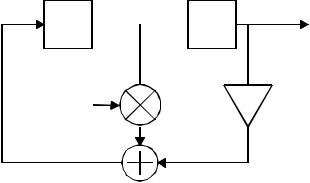
74 |
Chapter 5 |
we obtain from (5.3) a discrete-time sinusoidal function as the output signal:
Y (z) |
A (z2 |
cosθout |
z) |
||
|
|
|
|
(5.7) |
|
|
|
|
|
||
|
z |
2 2 cosθout z + 1 |
|||
It has complex-conjugate poles at p = exp(±jθout), and a unit sample response y(n) A cos(nθ out ), n ≥ 0 (5.8)
Thus the impulse response of the second-order system with complexconjugate poles on the unit circle is a sinusoidal waveform.
An arbitrary initial phase offset |
0 can be realized [Fli92], namely, |
|
|
y(n) |
A cos(θ out n + ϕ0 ), |
(5.9) |
|
by choosing the initial values: |
|
|
|
x1 (0) |
A cos(θout + ϕ0 ), |
(5.10) |
|
x2 (0) |
A cos(ϕ0 ). |
(5.11) |
|
Thus, any real-valued sinusoidal oscillator signal can be generated by the second-order structure shown in Figure 5.1.
In fact, the difference equation in (5.1) can be obtained directly from the trigonometric identity
A cos(θ out (n + 2)) A 2cos(θ out )cos(θ out (n + 1)) A cos(θ out n), (5.12) where, by definition, x2(n + 2) = Acos(cosθout(n + 2)).
The output sequence y(n) of the ideal oscillator is the sampled version of a pure sine wave. The angle θout represented by the oscillator coefficient is given by
θ out 2π fout / fs |
(5.13) |
where f ut is the desired output frequency. In an actual implementation, the multiplier coefficient 2 cosθout is assumed to have b + 2 bits. In particular, 1
ut is the desired output frequency. In an actual implementation, the multiplier coefficient 2 cosθout is assumed to have b + 2 bits. In particular, 1
x1 (n) |
x2(n) |
z-1  z-1
z-1
y(n)
2 cosθout |
-1 |
Figure 5.1. Recursive digital oscillator structure.
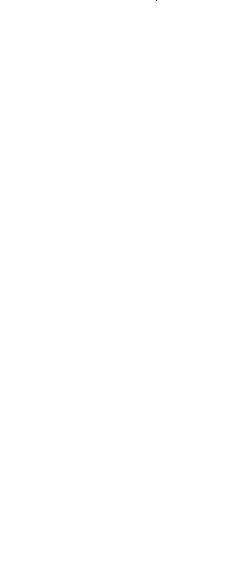
Recursive Oscillators |
75 |
bit is for the sign, 1 bit for the integer part and b bits for the remaining fractional part in the fixed-point number representation. Then the largest value of the coefficient 2 cosθout that can be represented is (2 – 2 b). This value of the coefficient gives the smallest value of θmin that can be implemented by the direct form digital oscillator using b bits
θ min |
1 ª 1 |
(2 2 |
b |
) |
º |
(5.14) |
||||
cos |
|
|
|
|
|
|
||||
¬2 |
|
¼ |
|
|||||||
|
|
|
||||||||
|
|
|
|
|
|
|
|
|||
Therefore, the smallest frequency that the oscillator can generate is
f |
|
θmin |
f |
|
(5.15) |
||
min |
2 |
π |
s |
||||
|
|
|
|||||
|
|
|
|
|
|||
where f is the sampling frequency. It should be emphasized that the frequency resolution of the direct-form oscillator is a function of the wordlength of the multiplier coefficient. Therefore, to increase the frequency resolution, the wordlength of the multiplier coefficient must be increased. Because the poles generated by a quantized coefficient (2 cosθout) are not uniformly distributed on the unit circle, the distance between two adjacent generated frequencies varies (the distance decreases as the generated frequency increases). The inability of the direct form digital oscillator to generate equally spaced frequencies is a disadvantage from the point of view of a communication system. A modified direct-form digital oscillator capable of generating almost equally spaced frequencies has been proposed in [Ali97]. However, it comes at a higher hardware cost as the solution in [Ali97] requires one additional multiplier and two integrators.
is the sampling frequency. It should be emphasized that the frequency resolution of the direct-form oscillator is a function of the wordlength of the multiplier coefficient. Therefore, to increase the frequency resolution, the wordlength of the multiplier coefficient must be increased. Because the poles generated by a quantized coefficient (2 cosθout) are not uniformly distributed on the unit circle, the distance between two adjacent generated frequencies varies (the distance decreases as the generated frequency increases). The inability of the direct form digital oscillator to generate equally spaced frequencies is a disadvantage from the point of view of a communication system. A modified direct-form digital oscillator capable of generating almost equally spaced frequencies has been proposed in [Ali97]. However, it comes at a higher hardware cost as the solution in [Ali97] requires one additional multiplier and two integrators.
Every time when the frequency is changed, a new set of parameters have to be computed. For the direct-form digital oscillator it is rather difficult to keep the phase continuous when the frequency is changed. This is a disadvantage if compared with the DDS (Figure 4-1).
In this digital oscillator, besides the zero-input response y(n) of the sec- ond-order system we get a zero-state response yerr(n) due to the random sequence e2(n) acting as an input signal. From (5.1) we obtain
y(n + 2) |
α y(n + 1) y(n) + e2 (n), |
(5.16) |
and by the z transformation |
|
|
Y (z) |
Yideal (z) + Yerr (z), |
(5.17) |
with Yideal (z) derived from (5.7). The z transform of the output error yerr(n) is given by
(z) derived from (5.7). The z transform of the output error yerr(n) is given by
Yerr (z) |
z2 |
E2 (z) |
z2 e2 (0) |
ze2 |
(1) |
(5.18) |
|
z2 |
2 cosθout |
z + 1 |
|
||
|
|
|
|
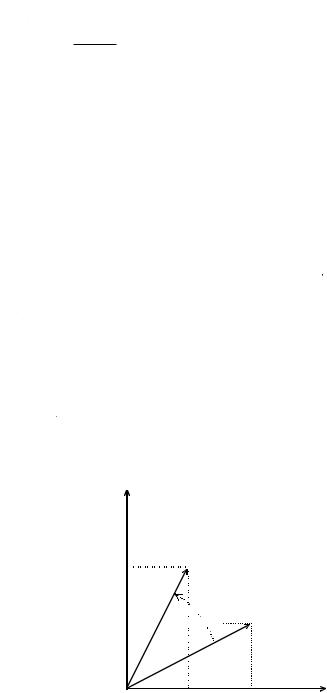
76 |
Chapter 5 |
with E2(z) being the z transform of the quantization error signal e2(n). Transforming Yerr(z) back into the time domain results in an output error sequence
n
yerr (n) θ1 ¦ e2 (k) sin(θout (n k + 1)) for n ≥ 2 (5.19)
sin out k 2
where e2(0) and e2(1) are assumed to be zero. Equation (5.19) shows that the output error is inversely proportional to sin(θout), thus the output error increases with the decreasing digital oscillator frequency. The accumulation of the quantization errors degrades the spectral purity of the generated wave and can produce computation overflows. Such computation overflows can easily make the oscillator unstable.
The output quantization error can be reduced by an appropriate error feedback [Abu86b]. In addition to the error feedback, a periodic oscillator reset could be applied. In order to eliminate an infinite accumulation of errors, the direct-form oscillator could be reset to its initial states after N samples (K cycles) if the normalized frequency θout/2 equals the rational number K/ N [Fur75]. This method is not effective for a large N, because the accumulated error will also be large. As a result, the signal spectrum will be degraded. Therefore, it is possible to reset the oscillator many times over one period (N) in [Fur75].
N [Fur75]. This method is not effective for a large N, because the accumulated error will also be large. As a result, the signal spectrum will be degraded. Therefore, it is possible to reset the oscillator many times over one period (N) in [Fur75].
5.2 Coupled-Form Complex Oscillator
The coupled-form digital oscillator generates simultaneously sine and the cosine waves (Asinθoutn and Acosθoutn) [Gol69], [Gor85], [Fli92], [Kro96], [Pro97], [Gra98], [Pal99], [Pal00], [Tur03] and can be obtained from the trigonometric formulae
x2(n+1)


 θout
θout
x2(n) 




















x1(n+1) x1(n)
Figure 5.2. Vector rotation
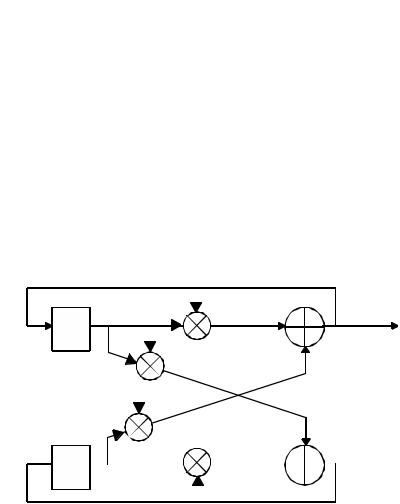
Recursive Oscillators |
|
A cos(α + β ) |
Acos(α )cos(β ) Asin(α ) sin(β ) |
A sin(α + β ) |
A cos(α )sin(β ) + A sin(α ) cos(β ), |
where, by definition, = nθout β = θout, and
x1 (n + 1) Acos((n + 1)θ out )
x2 (n + 1) Asin((n + 1)θ out ).
Thus we obtain the two coupled equations
x1 (n + 1) |
x1 (n) cos(θout ) x2 (n)sin(θ out ) |
x2 (n + 1) |
x1 (n) sin(θ out ) + x2 (n) cos(θ out ), |
77
(5.20)
(5.21)
(5.22)
that perform a general rotational transform anti-clockwise with angle θout the coordinates of a vector in Figure 5.2 transform from (x1 (n), x2(n)) to (x1 (n+1), x2(n+1)). The structure for the realization of the coupled-form oscillator is illustrated in Figure 5.3. This is a two-output system which is not driven by any input, but which requires the initial conditions x1 (0) = Acos(θout) and x2(0) = Asin(θout) in order to begin its self-sustaining oscillations.
Obviously, the total hardware cost of the coupled-form digital oscillator (Figure 5.3) is significantly higher than the cost of a direct-form oscillator (Figure 5.1). The coupled-form complex oscillator in Figure 5.3 could be implemented by a complex multiplier [Kro96], [Gra98], [Pal99], [Pal00]. The drawback of this method is low maximum clock frequency, which is limited by the speed of the complex multiplier. Due to the recursion, regular pipelining cannot be utilized [Pal00]. The design in [Gra98] uses CORDIC algorithm to compute the initial values.
Changing the frequency of the sinusoids generated by the coupled-form oscillator is simpler than in the case of the direct-form oscillator, because
cosθout
Acos((n+1)θout)
z-1 sinθout
-sinθout
Asin((n+1)θout)
 z-1
z-1 

cosθout
Figure 5.3. Coupled-form complex oscillator.

78 |
Chapter 5 |
only the oscillator’s coefficients have to be updated. Moreover, the change of frequency is phase continuous.
From the z transform of the state equations (5.22)
z X |
V X |
|
X |
[ |
|
|
|
|
|
|
|
|
|
|
|
|
|
]T |
(5.23) |
|
the characteristic equation |
|
|
|
|
|
|
|
|
|
|
|
|
|
|
|
|
|
|
|
|
D(z) |
z I |
V |
|
z |
cosθ out |
|
|
|
|
sinθ out |
|
|||||||||
|
|
|
|
|
|
|||||||||||||||
|
|
sinθ out |
|
|
z cosθ out |
(5.24) |
||||||||||||||
|
|
|
|
|
|
|
||||||||||||||
z2 |
− 2 cosθ out |
z + cos2 θ out |
+ sin2 θ out |
|
||||||||||||||||
can be derived. From (5.24), it is obvious that the eigenvalues (poles) are lying on the unit circle of the z plane. In a finite register length arithmetic, however, the eigenvalues almost never have exactly unit magnitude because the two coefficients cos(θout) and sin(θout) are realized separately. Thus we observe no stable limit cycle but a waveform with an increasing or decreasing amplitude. The stability of the oscillator is also influenced by the accumulation of the roundoff errors caused by finite wordlength arithmetic. Clearly, these negative effects can be reduced by increasing the internal wordlength of the oscillator. Unfortunately, this solution has a high negative impact on the total hardware cost. Moreover, the oscillator may become instable even if it happens after the higher number of oscillating cycles.
Because the poles of the coupled-form digital oscillator are conditioned by two coefficients, (cos(θout) and sin(θout)), they are uniformly distributed on a rectangular grid. As a result, the frequency resolution is improved in comparison to that of a direct-form oscillator (especially at low frequencies).
Equation (5.22) shows that x1 and x2 will both be sinusoidal oscillations that are always in exact phase quadrature. Furthermore, if quantization effects are ignored, then, for any time n, the equality
|
|
|
|
|
|
|
|
|
|
|
|
|
|
|
|
|
|
|
|
|
|
|
|
|
|
|
|
|
|
|
|
|
|
) |
(5.25) |
holds. In order to reset the system so that, after every k iterations, the variables x1(n) and x2(n) are changed to satisfy (5.25), we can multiply both x1 (n) and x2(n) by the factor
f (n) = |
x |
12 |
(0) + x22 |
(0) |
x12 (n) + x22 |
(5.26) |
|||
|
(n) |
|||
Thus, for each k iterations of (5.22), we perform once the non-linear iteration
x1 (n + 1) |
f (n)[ |
|
|
|
|
|
|
θ |
|
|
|
|
|
|
|
|
|
|
|
|
|
|
|
θ |
|
|
] |
(5.27) |
|||||||||
|
|
|
|
|
|
|
|
|
|
|
|
|
|
|
|
|
|
|
|
|
|
|
|
||||||||||||||
x2 (n + 1) |
f (n)[ |
|
|
|
|
|
|
|
|
θ |
|
|
|
|
|
|
|
|
|
|
|
|
|
|
|
|
|
|
|
θ |
|
|
|
|
] |
||
|
|
|
|
|
|
|
|
|
|
|
|
|
|
|
|
|
|
|
|
|
|
|
|
|
|
|
|
|
|
|
|
|
|
||||
Execution of (5.27) effectively resets x1 (n + 1) and x2(n + 1) so that (5.25) is satisfied. Thus, if x1 (n) and x2(n) had both drifted by the same rela-

Recursive Oscillators |
79 |
tive amount to a lower value, both would be raised, in one iteration cycle, to the value they would have had if no noise were present. If, however, x2(n) had drifted up and x1 (n) down so that the sum of the squares were satisfied (5.25), then (5.27) would have no effect. Thus the drifts of phase are not compensated by (5.27). In [Fli92], the amplitude gain is controlled by changing the oscillator coefficients. If f( n) is larger than one, then the coefficientset generating poles outside the unit circle are utilized. If f(
n) is larger than one, then the coefficientset generating poles outside the unit circle are utilized. If f( n) is smaller than one, then the coefficient-set generating poles inside the unit circle are used for computing the next sample. By these means, the amplitude of the generated waves is kept within given limits. Other amplitude correction methods are presented in [Gra98], [Pal99], [Pal00]. In these methods, the feedback signal is saturated if overflows or underflows occur. The most efficient method of eliminating the infinite accumulation of errors of the coupledform complex oscillator is to reset its initial states after N samples (K cycles) if the normalized frequency θout/2 equals the rational number K/
n) is smaller than one, then the coefficient-set generating poles inside the unit circle are used for computing the next sample. By these means, the amplitude of the generated waves is kept within given limits. Other amplitude correction methods are presented in [Gra98], [Pal99], [Pal00]. In these methods, the feedback signal is saturated if overflows or underflows occur. The most efficient method of eliminating the infinite accumulation of errors of the coupledform complex oscillator is to reset its initial states after N samples (K cycles) if the normalized frequency θout/2 equals the rational number K/ N
N
An increase in the frequency resolution requires that the word length of the whole complex oscillator is widened; however, in the case of the conventional direct digital synthesizer, it is only necessary to increase the phase accumulator word length (see (4.2)).
REFERENCES
[Abu86a] A. I. Abu-El-Haija, and M. M. Al-Ibrahim, "Digital Oscillator Having Low Sensitivity and Roundoff Errors," IEEE Trans. on Aerospace and Electronic Systems, Vol. AES-22, No. 1, pp. 23-32, Jan. 1986.
[Abu86b] A. I. Abu-El-Haija, and M. M. Al-Ibrahim, "Improving Performance of Digital Sinusoidal Oscillators by Means of Error-Feedback Circuits," IEEE Trans. Circuits Syst., Vol. CAS-33, pp. 373-380, Apr. 1986.
[Ali01] M. M. Al-Ibrahim, "A Multifrequency Range Digital Sinusoidal Oscillator with High Resolution and Uniform Frequency Spacing," IEEE Trans. on Circuits and Systems II, Vol. 48, No. 9, pp. 872-876, Sept. 2001.
[Ali97] M. M. Al-Ibrahim and A. M. Al-Khateeb, "Digital Sinusoidal Oscillator with Low and Uniform Frequency Spacing," IEE Proceedings on Circuits, Devices and Systems, Vol. 144, No. 3, pp. 185-189, June. 1997.
[Asg93] S. M. Asghar, and A. R. Linz, "Frequency Controlled Recursive Oscillator Having Sinusoidal Output," U. S. Patent 5,204,624, Apr. 20, 1993. [Fli92] N. J. Fliege, and J. Wintermantel, "Complex Digital Oscillators and FSK Modulators," IEEE Trans. on Signal Processing, Vol. SP-40, No. 2, pp. 333-342, Feb. 1992.
[Fur75] K. Furuno, S. K. Mitra, K. Hirano, and Y. Ito, "Design of Digital Sinusoidal Oscillators with Absolute Periodicity," IEEE Trans. on Aerospace and Electronic Systems, Vol. AES-11, No. 6, pp. 1286-1298, Nov. 1975.
